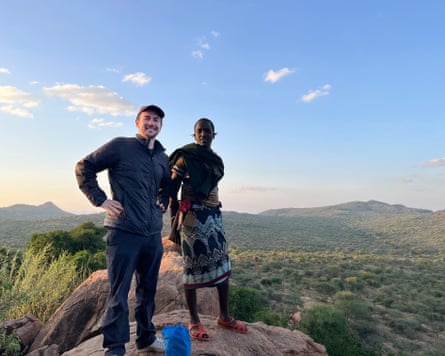Kenya’s growing towns are leaving elephants with nowhere to go
October 31, 2025
It is remarkably hard to see an elephant in the wild. In Oldonyiro, northern Kenya, they pass through the settlement almost every night. Piles of dung appear metres from the primary school and local church each morning, where smooth circles have been padded into the earth by the enormous beasts shuffling past in the dark.
But when I went looking for them in September, they were nowhere to be found.
More after this week’s most important reads.
Essential reads
-
How a radical experiment to bring a forest into a preschool transformed children’s health
-
‘White-knuckled wolf spider’ thought lost is rediscovered on Isle of Wight
-
Carnivorous ‘death ball’ sponge among new species found in depths of Southern Ocean
In focus

The Oldonyiro community – home to around 3,000 people – is emblematic of the complicated relationship between humans and elephants in many parts of Africa today. The region is home to the semi-nomadic Samburu people, who care for goats, camels and cattle in the arid landscape. Here, the number of people living from the land is growing – increasingly putting people and elephantsin direct competition for water and food. Elephants and the livestock both covet the acacia pods that fall from the trees, which cover the red soils around the traditional Samburu bomas – circular enclosures where people live with their livestock.
As competition for resources has increased, compounded by drought from global heating, so too have injuries and deaths from clashes in the area. Despite their enormous size, elephants are skittish and easily spooked, in part a consequence of the history of poaching that saw hundreds of thousands killed for their ivory in the last century. Some charge and trample people who they view as a threat.
To better understand the issue, I recently spent the day with Benjamin Loloju, who works with Save the Elephants and isfrom Oldonyiro. We took a tour of the settlement to see the bomas, where herders fight off hyenas and leopards who are trying to grab goats at night.
“My work is to ensure that corridors are open in northern Kenya and to maintain connectivity, so that wildlife, livestock and people can move from one area to another,” he said, as we rumbled along in the 4×4. “So much has changed in this area in the last 30 years from when I was a boy. It used to be one or two buildings. Now there are more than 100. We didn’t have all these cars and roads. It was virgin land,” Loloju explained.
We stopped the car and began to walk near the school, just metres from a main elephant migration route. At certain times of the year, hundreds can pass along this path in a single evening as the animals follow the seasonal rains to better feeding grounds. Many local people fear for their children’s lives on the way to school, he said.
The true scale of the challenge in Oldonyiro became clear at dusk. We climbed up to a rock that overlooks the valley – a favourite spot for baboons to spend the night. Loloju had a bag of beers in one hand as he scrambled up the boulder in the fading light. Local men joined us to drink and socialise as the sun set. In front of us, Loloju pointed out the bottleneck between the hills that forces the elephants to pass through Oldonyiro.
“Look at those mountains. There is only a small gap for the elephants. When they move for the rains, they have to go through there. For years, they have been passing here. It was an open landscape. Now, the humans are here. The buildings are approaching right inside the corridors,” he told me.
The next day, we spoke with Ntoimar Louwapere, whose son was crushed earlier this year by a bull elephant while he was out doing daily tasks. Others living nearby have similar stories. While no reliable numbers exist, experts say the issue is becoming increasingly deadly, for the animal population as well as the human one. In northern Kenya, human-elephant conflict has become a bigger threat to their survival than poaching.
“We have to find the balance. When we plan towns, yes, we are considering people, but let’s also find a way to live with the elephants,” said Loloju.
Read more:
-
Can communities living side by side with wildlife beat Africa’s national parks at conservation?
-
Nairobi’s lions are almost encircled by the city. A Maasai community offers a key corridor out
-
World’s landscapes may soon be ‘devoid of wild animals’, says nature photographer
Search
RECENT PRESS RELEASES
Related Post




